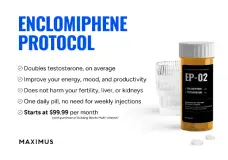madman
Super Moderator
Author Block: Sherman Mitchell Harman, MD, PhD1, Gurbir Gill, MD1, Garineh Ovanessoff, MD, MPH2, Gaja Andzel, MD3, JOHN MARCHETTE, PA4. 1Phoenix VA Health Care Syst, Phoenix, AZ, USA, 2Dignity Health/ St. Joseph's Hospital, Phoenix, AZ, USA, 3Be Well Endocrinology and Functional Medicine, Loma Linda, CA, USA, 4Phoenix VA Healthcare Sys, Phoenix, AZ, USA.
Disclosure Block: S.M. Harman: None. G. Gill: None. G. Ovanessoff: None. G. Andzel: None. J. Marchette: None.
Male hypogonadism (mHG) is defined as subnormal testosterone (T) and/or spermatogenesis. T therapy raises plasma T level, but suppresses FSH, LH, and T production. Clomiphene citrate (CC) inhibits estrogen negative feedback on GnRH secretion at the hypothalamus. In patients with central mHG and an intact pituitary, CC can increase LH-mediated endogenous T secretion. We compared T responses to oral CC in 31 male Veterans with central mHG (at least 2 T levels <250 ng/dL, low or low normal LH and FSH, and no pituitary abnormalities on MRI) who were naïve to T (NT, n=15) vs previously T-treated (TT, n=16) with last dose at least 3 months previously. Both groups were started on CC 25 mg/day PO. T was measured at 3 weeks and T and LH at 7 weeks. Those failing to achieve a goal T of ≥450 ng/dL at 3 weeks were up-titrated to 50 mg/day. Continuous values were compared by t-tests and ANOVA and class variables by Chi square tests. In the NT vs. TT groups respectively, baseline (mean ± SD) ages (48.1±13.4 vs 49.6±10.0 years, p=0.73), BMIs (35.6±4.2 vs 37.4±7.3 Kg/m2, p=0.40), and T (221±81 vs 178±70 ng/dL, p=0.13) as well as LH, FSH, SHBG, and prolactin did not differ significantly. At 3 weeks T levels in NT vs. TT were 474±217 vs. 361±148 ng/dL (p=0.11) and 47% vs 31% were at goal (p=0.38). In the NT vs. TT groups the 3-week T levels in those who had reached goal did not differ significantly from one another (641±186 vs. 528±81 ng/dL, p=0.14) nor in those not at goal (328±110 vs 285±100 ng/dL, p=0.47). At 7 weeks T levels were higher in the NT vs. TT group (591±203 vs 388±112 ng/dL, p=0.003) with 80% vs. 37% at goal (p=0.014). Those at goal at 3 weeks in the NT vs TT groups had significantly higher 7-week T levels (697±153 vs. 480±67 ng/dL, p=0.009) but those not at goal at 3 weeks (498±203 vs 346±104 ng/dL, p=0.08) did not. Increasing CC dose in those not at goal in the NT vs the TT groups led to 63% vs 18% achieving goal (p= 0.05). LH levels increased significantly (p<0.001) by 7 weeks in both NT and TT groups, but did not differ significantly between NT and TT groups at baseline (2.85±1.65 vs 3.05±1.65 ng/mL, p=0.75) or at 7 weeks (8.33±4.66 vs 8.94±4.52 ng/mL, p=0.72) with non-significant differences in LH between 7 weeks at goal and not at goal subjects respectively (9.43±5.05 vs 7.51±3.44 ng/mL, p=0.23). Although baseline testosterone in NT and TT subjects were similar, and those naïve to T were not significantly more likely to achieve goal at 3 weeks, NT subjects had higher plasma T levels at 7 weeks, and, if not at goal at 3 weeks, were more likely to reach goal after an increase in CC dose. Thus, previous T treatment impaired or delayed T response to CC, which appeared to be due mainly to Leydig cell dysfunction, since LH responses to CC did not differ between groups. Longer periods of treatment and/or higher doses of CC may be required to optimize T levels in mHG patients previously treated with exogenous T.
Disclosure Block: S.M. Harman: None. G. Gill: None. G. Ovanessoff: None. G. Andzel: None. J. Marchette: None.
Male hypogonadism (mHG) is defined as subnormal testosterone (T) and/or spermatogenesis. T therapy raises plasma T level, but suppresses FSH, LH, and T production. Clomiphene citrate (CC) inhibits estrogen negative feedback on GnRH secretion at the hypothalamus. In patients with central mHG and an intact pituitary, CC can increase LH-mediated endogenous T secretion. We compared T responses to oral CC in 31 male Veterans with central mHG (at least 2 T levels <250 ng/dL, low or low normal LH and FSH, and no pituitary abnormalities on MRI) who were naïve to T (NT, n=15) vs previously T-treated (TT, n=16) with last dose at least 3 months previously. Both groups were started on CC 25 mg/day PO. T was measured at 3 weeks and T and LH at 7 weeks. Those failing to achieve a goal T of ≥450 ng/dL at 3 weeks were up-titrated to 50 mg/day. Continuous values were compared by t-tests and ANOVA and class variables by Chi square tests. In the NT vs. TT groups respectively, baseline (mean ± SD) ages (48.1±13.4 vs 49.6±10.0 years, p=0.73), BMIs (35.6±4.2 vs 37.4±7.3 Kg/m2, p=0.40), and T (221±81 vs 178±70 ng/dL, p=0.13) as well as LH, FSH, SHBG, and prolactin did not differ significantly. At 3 weeks T levels in NT vs. TT were 474±217 vs. 361±148 ng/dL (p=0.11) and 47% vs 31% were at goal (p=0.38). In the NT vs. TT groups the 3-week T levels in those who had reached goal did not differ significantly from one another (641±186 vs. 528±81 ng/dL, p=0.14) nor in those not at goal (328±110 vs 285±100 ng/dL, p=0.47). At 7 weeks T levels were higher in the NT vs. TT group (591±203 vs 388±112 ng/dL, p=0.003) with 80% vs. 37% at goal (p=0.014). Those at goal at 3 weeks in the NT vs TT groups had significantly higher 7-week T levels (697±153 vs. 480±67 ng/dL, p=0.009) but those not at goal at 3 weeks (498±203 vs 346±104 ng/dL, p=0.08) did not. Increasing CC dose in those not at goal in the NT vs the TT groups led to 63% vs 18% achieving goal (p= 0.05). LH levels increased significantly (p<0.001) by 7 weeks in both NT and TT groups, but did not differ significantly between NT and TT groups at baseline (2.85±1.65 vs 3.05±1.65 ng/mL, p=0.75) or at 7 weeks (8.33±4.66 vs 8.94±4.52 ng/mL, p=0.72) with non-significant differences in LH between 7 weeks at goal and not at goal subjects respectively (9.43±5.05 vs 7.51±3.44 ng/mL, p=0.23). Although baseline testosterone in NT and TT subjects were similar, and those naïve to T were not significantly more likely to achieve goal at 3 weeks, NT subjects had higher plasma T levels at 7 weeks, and, if not at goal at 3 weeks, were more likely to reach goal after an increase in CC dose. Thus, previous T treatment impaired or delayed T response to CC, which appeared to be due mainly to Leydig cell dysfunction, since LH responses to CC did not differ between groups. Longer periods of treatment and/or higher doses of CC may be required to optimize T levels in mHG patients previously treated with exogenous T.














